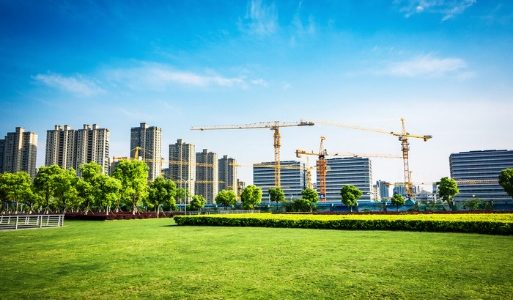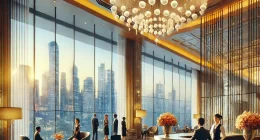Commercial buildings have a majority share when it comes to green buildings than residential sector. A research shows that only 5-7% of housing projects go for green buildings.
By Varun Singh
Commercial real estate sector is leading the green building culture in the country, with more than 90% share.
Heard it right, not many homes are being built green. But offices yes, they are being constructed green. A report by Anarock shows that a mere 5-7% of the overall green building stock is of housing projects.
Ashutosh Limaye, Director & Head – Consulting, ANAROCK Property Consultants, says, “Despite increasing awareness, most of the demand for sustainable buildings currently comes from consumers of commercial real estate – largely because a vast number of MNCs now insist on the kinds of sustainability features that only Grade A office buildings put on the table.”
If one consider numbers, the Indian Green Building Council (IGBC) started with a modest 20,000 sq. ft. green built-up area in the country in 2003. By 2019-end, IGBC reports that there were more than 5,723 green buildings projects registered under it, coming up across the country, accounting for over 7.09 billion sq. ft. area.
At least 1,932 of these green building projects are certified and already fully-functional in India. Majority of projects seeking the ‘green building’ tag are commercial spaces.
Below are some of the highlights one what is impacting the survival of green building construction in the country.
Why Buyers and Developers Shy Away
India’s green housing ‘movement’ actually had its roots in the country’s commercial sector that is the IT/ITeS boom years, when premium housing of all stripes was the preferred first home option for many. In those years, green housing projects became a kind of status symbol which proclaimed purchasing power.
When the global Dotcom bubble burst, India’s IT sector also took a hit. A not-insignificant number of housing loans for premium homes taken by over-confident software professionals – often freshers – turned bad. In this period, the demand for green homes was been closely correlated to the performance of the Indian software industry.
Today this demand is no longer confined to the IT/ITeS industry. However, in the current environment of highly constrained job growth across sectors – including IT/ITeS – the demand for essentially expensive green homes is quite low. Though affordable housing shows growth, luxury housing has lost its sheen – and green buildings still carry the ‘luxury’ tag.
Price is always a critical factor for first-time homebuyers and even today, most of them would prefer not to shell out anything more than is absolutely necessary. In short, green housing is still something of an elitist concept and option in India, rather than an imperative.
The price differences between certified green homes and non-green ones is significant for budget-conscious first-time homebuyers. Green homes are at least 10-15% costlier, depending on various facilities and factors. The fact that in the long run, a green home results in 30-40% savings on energy and water bills does not cut much ice.
The higher costs involved in developing green buildings are definitely a deterrent for many developers, as increased costs must be pushed on to buyers. Because of the price factor, the current demand for green housing comes more from financially settled buyers rather than from first-home buyers for whom such a price difference for what is essentially the same amount of space makes a considerable difference.
Also, a significant number of green home buyers show interest because they have travelled extensively and seen sustainable housing first-hand in other countries. This, again, implies superior purchasing power.
Though the government has given considerable emphasis and incentivization to sustainability features in contemporary housing, its greatest push is still towards affordable housing. Sustainability and affordability do not live on the same end of the pricing spectrum, and most developers are more focused on creating affordable rather than sustainable housing.
Prospects for Improvement?
This will change and already has to some extent. Many developers focus exclusively on integrated townships which are conceived firmly around sustainability concepts. Others have based their very brand positioning on green housing and do get a lot of interest for their offerings.
However, the hard fact is that the highest demand is currently for affordable housing, and even players who previously focused only on premium offerings have got on the affordable bandwagon.
The challenge before the industry and the government is to make sustainable housing affordable – and so far, this code has not been convincingly cracked. The problem lies not only in the more expensive features of green housing but also in the very perception of such housing being essentially premium, and therefore out of reach.
Our Environment is Paying the Price
There are options for developing land and buildings in ways which are less harmful to the environment. Sustainable development has a much lower site impact from the very design level onward and throughout the building’s lifecycle after construction. Concepts like scientific waste management, climactic control, waste water treatment and energy-preserving features are baked into a genuine, certified green housing project’s DNA. Sustainable buildings take into consideration their occupants’ health as well as the health of the environment around them.
However, such concepts must be applied right from the pre-construction phase and to the building’s impact after construction. Currently, sustainable construction practices are very cost-intensive. In an environment where cost of construction – and therefore cost to consumer – is a major concern, many developers will shy away from the added costs and compliances of green building practices.
It is pertinent to note that since energy and mass cannot be destroyed, no construction process – however sustainable – can be entirely free of environmental impact. It is no accident that the Delhi-NCR construction ban did not make an exclusion for green building constructions as the construction process always involves a certain amount of natural resource consumption, emissions and effluents, and air pollution.
How Can This Change?
The government has given a major push to less environmentally harmful automobiles. Increasingly, entire generations of automobiles are being mandatorily phased out to give way to better, cleaner ones. While one cannot phase out buildings just because they were built in less environmentally aware times, there can be a policy push towards retrofitting older buildings with sustainable features like rainwater harvesting, waste water treatment facilities and solar panel. Simultaneously, the policy approach towards newer constructions can be hardened to make such features mandatory. This features can easily be added in old commercial as well as residential real estate.
Interestingly, while older residential buildings were not built with the environment and today’s urban pressures in mind, they were often also more sustainable than newer constructions. The practice in previous times was to source construction materials locally, and the designs themselves had a lower environmental impact than many newer housing projects. The currently popular practice is to emulate global building designs. This involves the use of a lot of glass and metal – rendering many modern structures heavily dependent on air-conditioning to maintain bearable internal temperatures.
Another means at the government’s disposal is making the entire chain of green building technology more cost-effective via import and manufacturing exemptions. Developers who have rushed to affordable housing despite their previous market positioning for luxury were significantly motivated by heavy incentives given for creating affordable homes.
Such a policy approach, if backed by hard targets on the lines of Housing for All by 2022, can attract more developers to sustainable development. Buyers of green homes can be also be significantly incentivised, much along the lines being used for the use of electric cars. Property tax exemptions for green home owners can be raised from the current nominal savings to a substantial and impactful degree.
India’s famous Paris pledge was to drastically lower reduce the green house emission intensity of its gross domestic product (GHG emissions / unit GDP) by 33-35% per cent over 2005 levels by 2030. If we consider that the country’s GHE accounted for 6.5% of the global total in 2004, this was a massively ambitious target to set. Real estate development and consumption must be factored into meeting this target, or the country will not be able to honour this commitment.
If measures cited above are followed, one could see the shift from commercial towards residential when it comes to green buildings.









